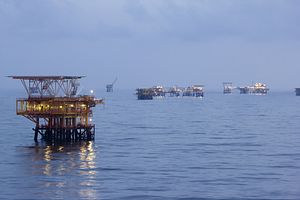The Rebalance authors Mercy Kuo and Angie Tang regularly engage subject-matter experts, policy practitioners and strategic thinkers across the globe for their diverse insights into the U.S. rebalance to Asia. This conversation with Dr. Casey Lucius – Professor of Theater Security Decision Making in the Department of National Security Affairs at the Naval War College in Monterey, California, a former U.S. Navy lieutenant who served with the U.S. Pacific Fleet and U.S. embassy in Hanoi, and author with select publications including Vietnam’s Political Process: How Education Shapes Decision Making (Routledge Press, 2009) and “China’s Critical Resource Strategy,” in China and International Security: History, Strategy and 21st Century Policy (Praeger 2014) – is the 21st in “The Rebalance Insight Series.”
Briefly describe a critical component of China’s natural resource strategy.
There are two ways to think about China’s natural resource strategy: either from the perspective of minerals or from the perspective of oil and natural gas. In both cases, China has implemented a long term natural resources strategy that maximizes the State’s control over exploration, production, pricing and exports. China developed a long term strategic plan for securing natural resources beginning with the first Five Year Plan in 1953. In 1982, the Ministry of Geology and Mineral Resources was created and took responsibility for mineral extraction and exploitation. In 1996, the National Mineral Resources Commission was established to ensure that the State would be the legal owner of all of the country’s mineral resources. A parallel process took place to control resources under the sea, including oil and natural gas. In 1982 China passed the Law on the Management of Sea Areas as well as various other regulations on the exploitation of offshore oil resources. Today, the Ministry of Land and Resources oversees all projects on land and at sea regarding natural resource claims. The point is, China has been thinking and planning for maximum control of natural resources, including minerals, rare earths, oil, and natural gas, for over sixty years. As a result, these long term planning decisions have created a situation in which much of the world now relies on China for critical natural resources.
With the launch of the Asian Infrastructure Investment Bank (AIIB), what is the role of AIIB, if any, in facilitating infrastructure development for resource extraction and access to natural resources in other countries?
It is hard to say yet how the pooling and lending of money from the AIIB will work. It could be positive in that money could be used by countries to build energy efficient infrastructure to help meet global climate change goals. Or it could be that China uses the AIIB as a mechanism to loan money to countries in exchange for uranium and other mineral ores in an effort to control access to critical minerals. In either case, being the leading member of AIIB is likely to strengthen China’s presence and prestige in shaping the region’s infrastructure industry.
With China’s predominance in the rare earths industry, what are implications for environmental conservation and U.S. vital interests in this sector?
Mining rare earths can be seen as a “green” solution to our increasing global energy demands, because the minerals are used in wind turbines, solar panels, hybrid batteries, catalytic converters, and energy efficient light bulbs. Rare earths are already playing a vital role in reducing greenhouse gas emissions. However, the U.S. is reliant on China for access to the rare earth components that allow for green technology production. For example, neodymium is used to make high strength rare earth magnets in electric motors for hybrid vehicles. There is a clear link between the country that controls the rare earth market and the country that achieves its energy independence and environmental conservation goals.
What is your outlook for U.S.-Vietnam relations in strengthening bilateral security and trade relations in the context of U.S. rebalance to Asia?
U.S.-Vietnam relations have improved steadily over the past twenty years since normalization, however, there is lingering distrust between Washington and Hanoi. This distrust combined with Hanoi’s independent foreign policy continues to keep Vietnam and the United States’ relationship at arm’s length. Vietnam does not want to be put in the middle of tensions between the U.S. and China or between the U.S. and Russia – Vietnam’s largest arms supplier. Clearly Vietnam welcomes increased U.S. patrols in the South China Sea to challenge Beijing’s expanding territorial claims. Similarly, with the passage of TPP, trade is likely to increase between Vietnam and the United States. Therefore, despite the limitations to enhanced military relations, we are likely to see improved political and economic relations.
What key factors should the next U.S. president understand about China’s critical resource strategy?
You need only look to 2010 when China cut off exports of critical minerals to Japan in order to achieve the release of a Chinese fishing vessel captain being held in Japan. The minerals were rare earths that Japan needed for its hybrid car manufacturing as well as for the production of guided missiles. At the same time, China began cutting worldwide export quotas and launched a new unified pricing system to better control the availability, supply, and pricing of these critical resources. China is likely to use similar tactics against other countries by controlling several islands in the East and South China Seas where Beijing has territorial claims in order to access billions of barrels of oil. One of China’s famous military slogans is “win without fighting.” Through the control of critical minerals and territorial claims in the South China Seas, China will potentially be able to control global maritime trade, and dominate most industries that rely on natural resources held by China. In other words, China’s natural resources strategy is not just about minerals or oil, it’s about gaining power and influence without ever firing a shot.































